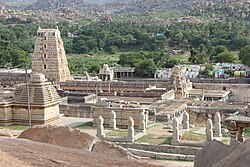Vijayanagara | |
|---|---|
City | |
 Virupaksha Temple, Vijayanagara, Karnataka | |
| Coordinates: 15°16′08″N 76°23′27″E / 15.2689°N 76.3909°E | |
| Country | |
| State | Karnataka |
| District | Vijayanagara |
| Founded by | Harihara I and Bukka |
| Named for | City of Victory |
| UNESCO World Heritage Site | |
|---|---|
 | |
| Location | Hampi (City), Vijayanagara district, Karnataka, India[1] |
| Includes | Virupaksha Temple |
| Criteria | Cultural: i, iii, iv |
| Reference | 241 |
| Inscription | 1986 (10th Session) |
| Endangered | 1999–2006 |
| Area | 4,187.24 ha |
| Buffer zone | 19,453.62 ha |
| Website | Archaeological Survey of India – Hampi |
| Coordinates | 15°20′04″N 76°27′44″E / 15.33444°N 76.46222°E |
Vijayanagara (transl. 'City of Victory') was a city at the modern location of Hampi, in the Indian state of Karnataka.[2] Vijayanagara was the capital city of the historic Vijayanagara Empire.[2] Located on the banks of the Tungabhadra River, it spread over a large area and included sites in the Vijayanagara district, the Ballari district, and others around these districts. A part of Vijayanagara ruins known as the Group of Monuments at Hampi has been designated as a UNESCO World Heritage Site.[3]
Hampi, an ancient human settlement mentioned in Hindu texts, houses pre-Vijayanagara temples and monuments.[4] In the early 14th century, the dominant Kakatiyas, Seuna Yadavas, Hoysalas, and the short-lived Kampili kingdom, who inhabited the Deccan region, were invaded and plundered by armies of Khalji and later Tughlaq dynasties of the Delhi Sultanate.[5]
Vijayanagara was founded from these ruins by the Sangama brothers, who were working as soldiers in the Kampili Kingdom under Kampalidevaraya.[2][5][6] The city grew rapidly. The Vijayanagara-centred empire functioned as a barrier to the Muslim sultanates in the north, leading to the reconstruction of Hindu life and scholarship, multi-religious activity, rapid infrastructure improvements, and economic activity.[2][7][8] Along with Hinduism, Vijayanagara accepted communities of other faiths such as Jainism and Islam, leading to multi-religious monuments and mutual influences.[9][10] Chronicles left by Persian and European travellers state Vijayanagara to be a prosperous and wealthy city.
By 1500 CE, Hampi-Vijayanagara was the world's second largest medieval era city (after Beijing) and probably India's richest at that time, attracting traders from Persia and Portugal.[11][12]
Wars between nearby Muslim Sultanates and Hindu Vijayanagara continued, however, through the 16th century. In 1565, the Vijayanagara leader Aliya Rama Raya was captured and killed,[13][14] and the city fell to a coalition of Muslim Sultanates of the Deccan Plateau. The conquered capital city of Vijayanagara was looted and destroyed for 6 months, after which it remained in ruins.[3][15][16]
- ^ Buradikatti, Kumar (19 November 2020). "Ballari set to lose Hampi and more". The Hindu.
- ^ a b c d Vijayanagara, Encyclopaedia Britannica
- ^ a b Anila Verghese 2002, pp. 1–18
- ^ Fritz & Michell 2016, pp. 12–33, 66–69.
- ^ a b David M. Knipe (2015). Vedic Voices: Intimate Narratives of a Living Andhra Tradition. Oxford University Press. pp. 38–39. ISBN 978-0-19-026673-8.
- ^ Burton Stein (1989). The New Cambridge History of India: Vijayanagara. Cambridge University Press. pp. 18–19. ISBN 978-0-521-26693-2.
- ^ Verghese, Anila; Eigner, Dieter (1998). "A Monastic Complex in Vithalapura, Hampi Vijayanagara". South Asian Studies. 14 (1): 127–140. doi:10.1080/02666030.1998.9628555.
- ^ Fritz, John M. (1986). "Vijayanagara: Authority and Meaning of a South Indian Imperial Capital". American Anthropologist. 88 (1): 44–55. doi:10.1525/aa.1986.88.1.02a00030. S2CID 143926888.
- ^ Fritz & Michell 2016, pp. 77–81, 97.
- ^ Catherine B Asher (1985), Islamic Influence and the Architecture of Vijayanagara, in A. L. Dallapiccola et al (Eds), Vijayanagara: City and Empire— New Currents of Research, Weisbaden: Steiner Verlag, pp. 188-95
- ^ Michael C. Howard (2011). Transnationalism and Society: An Introduction. McFarland. pp. 77–78. ISBN 978-0-7864-8625-0.
- ^ Nicholas F. Gier (2014). The Origins of Religious Violence: An Asian Perspective. Lexington. pp. 11–14. ISBN 978-0-7391-9223-8., Quote: "In its peak of glory, ca. 1500, with a population of about 500,000 and sixty square miles in area, Vijayanagara was the second largest city in the world behind Beijing."
- ^ Hermann Kulke; Dietmar Rothermund (2004). A History of India. Routledge. p. 191. ISBN 978-0-415-32920-0., Quote: "When battle was joined in January 1565, it seemed to be turning in favor of Vijayanagara - suddenly, however, two Muslim generals of Vijayanagara changes sides. Rama Raya was taken prisoner and immediately beheaded."
- ^ Eaton 2006, pp. 98, Quote: "Husain (...) ordered him beheaded on the spot, and his head stuffed with straw (for display).".
- ^ Fritz & Michell 2016, pp. 11–23.
- ^ Lycett, Mark T.; Morrison, Kathleen D. (2013). "The Fall of Vijayanagara Reconsidered: Political Destruction and Historical Construction in South Indian History 1". Journal of the Economic and Social History of the Orient. 56 (3): 433–470. doi:10.1163/15685209-12341314.



